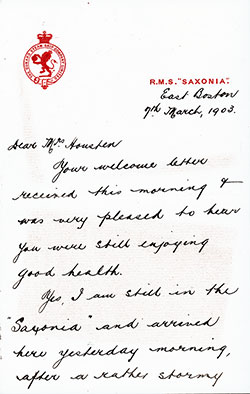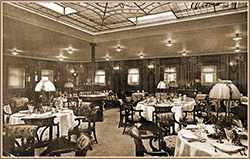Ocean Travel Correspondence
The GG Archives has a number of letters written by passengers on ocean liners from the late 1800s through the 1920s. Digitizing handwritten letters is a very time-consuming task.
If you're interested in volunteering, contact us a history@ggarchives.com and please title your message "volunteer transcriber."

J. W. Bailey Letter - RMS Saxonia - 1903
The RMS Saxonia’s March 1903 journey, marked by stormy weather, a tragic death, and a large influx of immigrants, encapsulates both the hopes and hardships of ocean travel at the time. This rich archival material serves as a valuable resource for historians, educators, students, and genealogists alike, offering a snapshot of life at sea during a pivotal era in transatlantic migration.

The Isaac Hardy Letters - RMS Carpathia - 1904
The Isaac Hardy letters, written during a transatlantic voyage aboard the RMS Carpathia in 1904, provide a rich and intimate glimpse into ocean travel in the early 20th century. These letters, penned by a retired English brick factory superintendent, Isaac Hardy (1833-1905), and his wife Mary Slack Hardy (1833-1910), document their seventh journey across the Atlantic. Their detailed daily accounts offer firsthand observations on shipboard life, travel conditions, and the experiences of passengers in second-class accommodations.

Voyage on the Ocean Liner Amerika 1912
This detailed and lively letter, published in The Hardware Reporter in 1912, offers a first-hand account of transatlantic travel aboard the SS Amerika, a luxurious ocean liner operated by the Hamburg America Line. The author, known as "Cub", provides a vivid narrative of life aboard a first-class voyage, describing not only the grandeur of the ship and its accommodations but also the fascinating array of fellow passengers, ranging from millionaires and diplomats to military officers and business magnates.
Recap and Summary of the Ocean Travel Correspondence Index Page
The Ocean Travel Correspondence section of the GG Archives is a treasure trove of first-hand passenger letters, offering unparalleled insight into life aboard transatlantic liners from the late 1800s through the 1920s. These digitized letters capture the personal experiences, emotions, and observations of travelers from diverse backgrounds, making them a valuable resource for historians, educators, genealogists, and students.
Each correspondence presents a unique perspective on ocean travel, highlighting everything from immigration struggles and onboard tragedies to the lavish comforts of first-class voyages. Below are the most interesting and notable pieces in this collection, along with what makes them particularly compelling.
Highlighted Correspondences
1. J.W. Bailey Letter – RMS Saxonia (1903)
📌 Key Themes: Stormy Weather, Immigrant Experience, Death at Sea
One of the most gripping letters in the collection, the J.W. Bailey correspondence recounts the March 1903 voyage of the RMS Saxonia from Liverpool to Boston. This journey was defined by stormy weather, a large influx of immigrants, and a tragic death at sea—a young Swedish girl who perished and was buried in the Atlantic.
💡 Why it’s fascinating:
- Captures the harsh realities of steerage passengers, many of whom were seeking new lives in America.
- Highlights the dangers of transatlantic travel, including unpredictable weather and onboard fatalities.
- Offers a historical snapshot of immigration patterns in the early 20th century.
2. Isaac Hardy Letters – RMS Carpathia (1904)
📌 Key Themes: Daily Life at Sea, Second-Class Accommodations, July 4th Celebrations
The Isaac Hardy letters, written during a 1904 voyage aboard the RMS Carpathia, provide a deeply personal and detailed diary-style account of life at sea. Isaac Hardy, a retired English brick factory superintendent, and his wife Mary describe their seventh Atlantic crossing, offering insights into second-class travel, shipboard entertainment, and even seasickness.
💡 Why it’s fascinating:
- Offers day-by-day observations of ship life, weather conditions, food, and onboard social activities.
- Features a rare glimpse into a second-class passenger’s experience, in contrast to the glamorous first-class accommodations often written about.
- Includes a lively account of July 4th celebrations aboard the Carpathia, showcasing transatlantic cultural exchanges.
3. Voyage on the Ocean Liner Amerika (1912)
📌 Key Themes: First-Class Luxury, Elite Travelers, Social Culture
Perhaps the most glamorous letter in the collection, this 1912 correspondence was published in The Hardware Reporter and written by an author known as "Cub". It provides a rich narrative of first-class travel aboard the SS Amerika, a Hamburg America Line luxury liner. This letter is a first-hand account of high society at sea, detailing interactions with millionaires, diplomats, military officers, and business magnates.
💡 Why it’s fascinating:
- Offers a rare and immersive description of first-class elegance, from fine dining at the Ritz-Carlton Restaurant to high-society entertainment.
- Gives insight into the social circles of the wealthy and influential elite on board.
- Highlights the stark contrast between first-class opulence and the challenging conditions of third-class immigrants on the same vessel.
Why This Collection Matters
This Ocean Travel Correspondence archive is a valuable historical resource, capturing the personal side of ocean liner voyages. These letters provide:
- Firsthand insights into transatlantic migration, from the struggles of steerage passengers to the luxuries of first-class travelers.
- Vivid descriptions of shipboard life, including entertainment, accommodations, and weather conditions.
- Personal perspectives on maritime history, social class differences, and the evolving nature of ocean travel.
For teachers and students, these letters are excellent primary sources for studying immigration, maritime history, and early 20th-century travel. For genealogists, they offer detailed accounts of passenger experiences, which may be useful for family research. And for historians, they provide a rich tapestry of narratives that help humanize historical events.
Final Thoughts
The Ocean Travel Correspondence section is not just a collection of letters—it’s a living archive of human stories. Whether it’s the tragedy of a young girl lost at sea, the joys of a July 4th celebration aboard the Carpathia, or the decadence of first-class life on the Amerika, each letter provides a unique window into the past.
For those passionate about maritime history, transatlantic travel, and personal narratives from the early 20th century, this collection is an invaluable and captivating resource.
